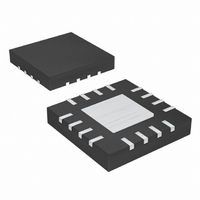MAX5089ATE+ Maxim Integrated Products, MAX5089ATE+ Datasheet - Page 16

MAX5089ATE+
Manufacturer Part Number
MAX5089ATE+
Description
IC DC-DC CONV BUCK 16TQFN
Manufacturer
Maxim Integrated Products
Type
Step-Down (Buck)r
Datasheet
1.MAX5089ATE.pdf
(24 pages)
Specifications of MAX5089ATE+
Internal Switch(s)
Yes
Synchronous Rectifier
Yes
Number Of Outputs
1
Voltage - Output
0.6 ~ 20 V
Current - Output
2A
Frequency - Switching
200kHz ~ 2.2MHz
Voltage - Input
4.5 ~ 23 V
Operating Temperature
-40°C ~ 125°C
Mounting Type
Surface Mount
Package / Case
16-TQFN Exposed Pad
Power - Output
2.67W
Lead Free Status / RoHS Status
Lead free / RoHS Compliant
rent through the internal power MOSFET (P
The total power dissipated in the package must be lim-
ited so the junction temperature does not exceed its
absolute maximum rating of +150°C at maximum ambi-
ent temperature. Calculate the power lost in the
MAX5088/MAX5089 using the following equations:
The power dissipated in the switch is:
where:
∆I
The power lost due to switching the internal power
MOSFET is:
t
MOSFET measured at SOURCE.
The power lost due to the switching quiescent current
of the device is:
The switching quiescent current (I
MAX5088/MAX5089 is dependent on switching fre-
quency. See the Typical Operating Characteristics sec-
tion for the value of I
In the case of the MAX5089, the switching current
includes the synchronous rectifier MOSFET gate-drive
current (I
charge (Q
and the switching frequency.
where the Q
nous rectifier MOSFET at V
The total power dissipated in the device is:
Calculate the temperature rise of the die using the fol-
lowing equation:
2.2MHz, 2A Buck Converters with an
Integrated High-Side Switch
16
R
P-P
and t
I
______________________________________________________________________________________
RMS MOSFET
is the peak-to-peak inductor current ripple.
F
P
SW-DL
are the rise and fall times of the internal power
_
Q
g-DL
P
P
P
g-DL
= V
I
SW
SW-DL
MOSFET
TOTAL
P
) of the synchronous rectifier MOSFET
). The I
T
Q
IN
=
J
is the total gate charge of the synchro-
= V
= T
V
x (I
=
IN
= Q
= P
SW
IN
C
= I
SW
×
(
SW-DL
I
OUT
I
g-DL
MOSFET
+ (P
OUT
x I
at a given frequency.
RMS_MOSFET
+ I
SW
GS
2
SW-DL
TOTAL
×
x f
×
depends on the total gate
(
4
= 5V.
D
t
SW
R
+ P
)
+
+
)
x θ
t
SW
F
∆
)
I
JC
x R
P P
×
+ P
−
f
12
)
SW
ON
2
Q
SW
×
(MAX5088)
(MAX5089)
D
) of the
MOSFET
).
θ
1.7°C/W. T
the junction temperature, or die temperature. The case-
to-ambient thermal resistance is dependent on how
well heat can be transferred from the PC board to the
air. Solder the underside exposed pad to a large cop-
per GND plane. If the die temperature reaches +170°C
the MAX5088/MAX5089 shut down and do not restart
again until the die temperature cools by 25°C.
The MAX5088/MAX5089 have an internal transconduc-
tance error amplifier with an inverting input (FB) and
output (COMP) available for external frequency com-
pensation. The flexibility of external compensation and
high switching frequencies for the MAX5088/MAX5089
allow a wide selection of output filtering components,
especially the output capacitor. For cost-sensitive
applications, use high-ESR aluminum electrolytic
capacitors. For size sensitive applications, use low-ESR
tantalum or ceramic capacitors at the output.
Before designing the compensation components, first
choose all the passive power components that meet
the output ripple, component size, and component cost
requirements. Secondly, choose the compensation
components to achieve the desired closed-loop band-
width and phase margin. Use a simple 1-zero, 2-pole
pair (Type II) compensation if the output capacitor ESR
zero frequency (f
crossover frequency (f
III) compensation when the f
Use procedure 1 to calculate the compensation net-
work components when f
Procedure 1 (see Figure 3)
Calculate the f
Calculate the unity-gain crossover frequency as:
If f
compensation network where R
zero (f
JC
ZESR
is the junction-to-case thermal resistance equal to
mid,zero
is lower than f
C
) and R
is the temperature of the case and T
ZESR
f
f
LC
ZESR
=
and f
F
ZESR
2
C
=
π
C
CF
2
C
f
×
C
π
and close to f
). Use a 2-zero, 2-pole (Type
ZESR
LC
provides a high-frequency pole.
×
=
) is below the unity-gain
L C
ESR C
double pole:
1
ZESR
f
×
SW
20
< f
1
F
OUT
C
×
C
is higher than f
F
.
OUT
provides a midband
Compensation
LC
, use a Type II
C
.
J
is












